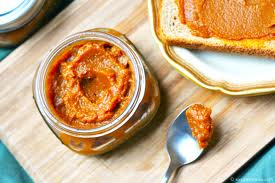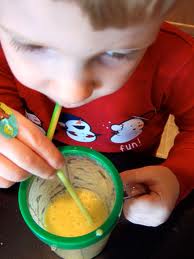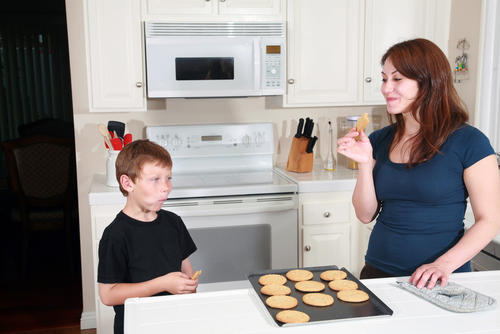
Toddlers and children can be very picky eaters. There are scientific studies that point to reasons why this is so. For one, there is rapid growth the average one-year-old undergoes, and following such a developmental process, (kids between one and three years of age), toddlers gain weight more slowly. This equates to needing less food. The amount of learning, discovering and adaptation that takes place daily also affects their eating patterns. Because little ones rarely sit still for long periods of time, even meal times, snacking their way through the day is more compatible with their lifestyle than sitting down to a full-fledged feast.
Toddlers and children need more of the right foods presented to them as choices. They are very influential creatures and will emulate foods that are bought, prepared and eaten by their role models, parents and guardians. The amount in which each child eats, when they eat, and if they eat, is mostly their responsibility (though we may take the credit or the blame most of the time).
It is good to know that most toddlers like to binge on one food at a time. They may eat only fruits one day, and vegetables the next. Since erratic eating habits are as normal as toddler mood swings, expect your child to eat well one day and eat practically nothing the next. Toddlers from one to three years need between 1,000 and 1,300 calories a day, yet they may not eat this amount every day. Aim for a nutritionally-balanced week, not a balanced day. Also know that milestones such as cutting teeth, growth spurts, and changes in the environment (vacationing, traveling, season change, and starting school) or visitors (people outside their normal household visiting) may affect the eating patterns.
All this is not to say that parents shouldn't encourage their toddlers to eat well and develop healthy food habits.
Make grocery shopping a fun activity together. Not only will they feel good about picking out their own produce and favorite snacks, they will learn about different seasonal foods, how to best select them, making their own food choices and will, in the long run, empower them to be more confident when it comes to fresh foods from the market.
Now that they have helped select the foods you will make at home, have them assist in the kitchen and watch the process of preparing the foods. Kids love to be of assistance and will more likely eat the foods they helped make. Even washing the vegetables or sprinkling some seasoning is enough for most toddlers to be willing to eat what they helped cook.

Toddlers like to graze their way through a variety of foods, and may get overwhelmed with a huge offering of foods at one time. Use an ice-cube tray, a muffin tin, or a compartmentalized dish, and put small bite-size portions of colorful and nutritious foods in each section. Call these finger foods playful names that a two-year-old can appreciate, such as:
•apple moons (thinly sliced)
•avocado boats (a quarter of an avocado)
•banana wheels
•broccoli trees (steamed broccoli florets)
•carrot swords (cooked and thinly sliced)
•cheese building blocks
•egg canoes (hard- boiled egg wedges)
•little O's (o-shaped cereal)
Young children think that immersing foods in a tasty dip is pure fun (and delightfully messy). Some possibilities to dip into:
•cottage cheese or tofu dip
•organic ketchup
•pasta sauce
•salad dressing
•cream cheese
•fruit juice-sweetened preserves
•guacamole
•peanut butter, thinly spread
•pureed fruits or vegetables
•yogurt, plain or sweetened with juice concentrate
Those dips serve equally well as spreads on apple or pear slices, bell pepper strips, rice cakes, bagels, toast, or other nutritious platforms.
Toddlers like spreading, or more accurately, smearing. Show them how to use a table knife to spread cheese, peanut butter, and fruit concentrate onto crackers, toast, or rice cakes.

Toddlers are into toppings. Putting nutritious, familiar favorites on top of new and less-desirable foods is a way to broaden the finicky toddler's menu. Favorite toppings are yogurt, cream cheese, melted cheese, guacamole, tomato sauce, applesauce, and peanut butter.
If your youngster would rather drink than eat, don't despair. Make a smoothie – together. Milk and fruit – along with supplements such as juice, egg powder, wheat germ, yogurt, honey, and peanut butter – can be the basis of very healthy meals. So what if they are consumed through a straw? One note of caution: Avoid any drinks with raw eggs or you'll risk salmonella poisoning.

How much a child will eat may depend on how you cut it. Make eating fun by cutting sandwiches, pancakes, waffles, and pizza into various shapes using cookie cutters.
Appearance and color is important (just ask any marketing agency for kids). For something new and different, why not use your child's own toy plates for dishing out a snack? Be creative. Think fun containers such as plastic measuring cups and ice-cream cones.
You can also try the scaled-down approach. Either serve pint-size portions or, when they're available, buy munchkin-size foodstuffs, such as mini bagels, mini quiches, chicken drummettes (the meat part of the wing), and tiny muffins.
Toddlers and children should be offered three to five servings of veggies a day, for children under five; each serving need be only a tablespoon for each year of age. In other words, a two-year-old should ideally consume two tablespoons of vegetables three to five times a day.
Let her help care for the plants, harvest the ripe vegetables, and wash and prepare them. She will probably be much more interested in eating what she has helped to grow.
Try adding them to rice, cottage cheese, cream cheese, guacamole, or even macaroni and cheese. Zucchini pancakes are a big hit at our house, as are carrot muffins.
They are much more flavorful and usually sweeter than when raw. Drizzle with olive oil and Parmesan cheese or mix with butter. Root vegetables taste great with a small dollop of raw coconut oil.
Create colorful faces with olive- slice eyes, tomato ears, mushroom noses, bell-pepper mustaches, and any other playful features you can think of. Our eighth child, Lauren, loved to put olives on the tip of each finger. "Olive fingers" would then nibble this nutritious and nutrient-dense food off her fingertips. Zucchini pancakes make a terrific face to which you can add pea eyes, a carrot nose, and cheese hair.

There are all kinds of possible variations on the old standby "cheese in the trees" (cheese melted on steamed broccoli florets). Or, you can all enjoy the pleasure of veggies topped with peanut- butter sauce, a specialty of Asian cuisines.
If your child is going through a picky-eater stage, invite over a friend who is the same age or slightly older whom you know "likes to eat." Your child will catch on. Group feeding lets the other kids set the example, and just like other pack animals, children tend to eat more when around other people their same age because of the competitive edge.
Keep food servings small. Wondering how much to offer? Here's a rule of thumb – or, rather, of hand. A young child's stomach is approximately the size of his fist. So dole out small portions at first and refill the plate when your child asks for more. This less-is-more meal plan is not only more successful with picky eaters; it also has the added benefit of stabilizing blood-sugar levels, which in turn minimizes mood swings. As most parents know, a hungry kid is generally not a happy kid.
"Take one bite, two bites…" (however far you think you can push it without force-feeding). The bite rule at least gets your child to taste a new food, while giving her some control over the feeding. As much as you possibly can, let your child – and his appetite – set the pace for meals. But if you want your child to eat dinner at the same time you do, try to time his snack-meals so that they are at least two hours before dinner.
Give your toddler shelf space. Reserve a low shelf in the refrigerator for a variety of your toddler's favorite (nutritious) foods and drinks. Whenever she wants a snack, open the door for her and let her choose one. This tactic also enables children to eat when they are hungry, an important step in acquiring a healthy attitude about food.

Whether it is a blender, juicer, and food processor, even a spatula or wooden spoon to mix and prepare the foods to make smoothies and other recipes with fruits and vegetables, with the proper supervision, children will love try foods they helped make with the fun mechanical devices.
One reason why toddlers don't like to sit still at the family table is that their feet dangle. Try sitting on a stool while eating. You naturally begin to squirm and want to get up and move around. Children are likely to sit and eat longer at a child-size table and chair where their feet touch the ground.
The distinctions between breakfast, lunch, and dinner have little meaning to a child. If your youngster insists on eating pizza in the morning or fruit and cereal in the evening, go with it – better than her not eating at all. This is not to say that you should become a short-order cook, filling lots of special requests, but why not let your toddler set the menu sometimes? Other family members will probably enjoy the novelty of waffles and hash browns for dinner.
Just like the real food preparation, children are more likely to eat their own creations, even when it is through simple play and imagination. Use cookie cutters, play or plastic foods, or simple sand at the park to create a delicious meal from farm to table. Children will carry their playtime into real meal times if good examples and dialogues are practiced in play.
Offer your child foods that pack lots of nutrition into small doses. This is particularly important for toddlers who are often as active as rabbits, but who seem to eat like mice.
•California Avocados
•Pasta
•Broccoli and other dark leafy greens
•Peanut, almond or other nut butters
•Brown rice, quinoa and other grains
•Sweet potatoes
•Cheese
•Poultry
•Eggs
•Squash
•Fish
•Kidney beans
•Tofu
•Yogurt
•Seaweed
For young children, what and how much they are willing to eat may vary daily. This capriciousness is due in large part to their ambivalence about independence, and eating is an area where they can act out this confusion. Do not be surprised if your child eats a heaping plateful of food one day and practically nothing the next, adores broccoli and blueberries for a period of time and suddenly refuses even looking at it, wants to feed herself at one meal and be totally catered to at another. Try to go with the flow of how your child is feeling, do not take their eating patterns personally and know that they are more than likely, doing fine.
We all know what our children’s favorite foods are, whether they are freeze dried yogurt drops, bite sized grapes, frozen blueberries, tiny chocolate morsels, frozen yogurt or even strawberries dipped in whipped cream. Offer small rewards for eating vegetables or foods they otherwise would have brushed off their plate. Do not make the rewards a big deal, but rather a part of the meal process, as a last course. Most children just like to feel like they get to taste and nibble on their favorite treat. Why not make meal time end on positive note? Offer two of their favorite choices and make them healthy! Fruit and yogurt are always great options. Most importantly, relax. Your children will eventually develop a greater palate, will explore and eat more foods as they grow older.
Sources: AskDrSears.com, babycenter.com, CNN.com, Parents.com, SeriousEats.com
